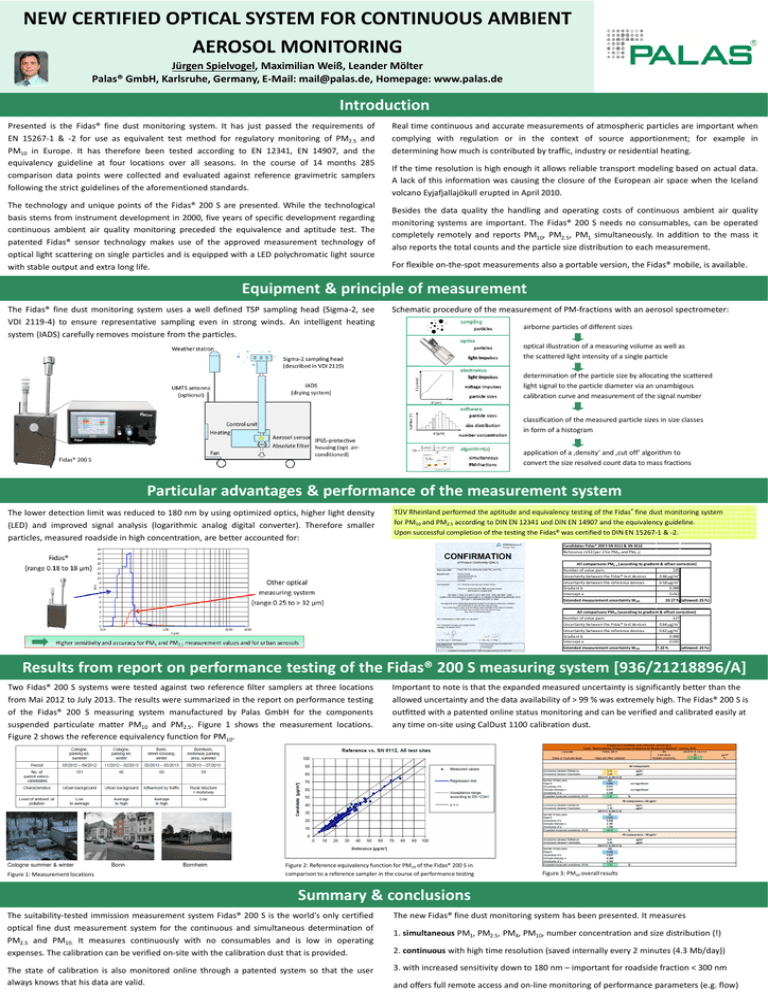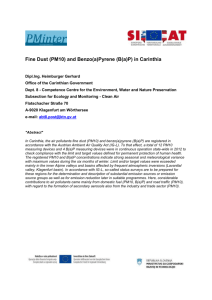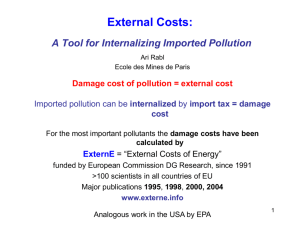new certified optical system for continuous ambient aerosol monitoring
advertisement

NEW CERTIFIED OPTICAL SYSTEM FOR CONTINUOUS AMBIENT AEROSOL MONITORING Jürgen Spielvogel, Maximilian Weiß, Leander Mölter Palas® GmbH, Karlsruhe, Germany, E-Mail: mail@palas.de, Homepage: www.palas.de Introduction Presented is the Fidas® fine dust monitoring system. It has just passed the requirements of EN 15267-1 & -2 for use as equivalent test method for regulatory monitoring of PM2.5 and PM10 in Europe. It has therefore been tested according to EN 12341, EN 14907, and the equivalency guideline at four locations over all seasons. In the course of 14 months 285 comparison data points were collected and evaluated against reference gravimetric samplers following the strict guidelines of the aforementioned standards. The technology and unique points of the Fidas® 200 S are presented. While the technological basis stems from instrument development in 2000, five years of specific development regarding continuous ambient air quality monitoring preceded the equivalence and aptitude test. The patented Fidas® sensor technology makes use of the approved measurement technology of optical light scattering on single particles and is equipped with a LED polychromatic light source with stable output and extra long life. Real time continuous and accurate measurements of atmospheric particles are important when complying with regulation or in the context of source apportionment; for example in determining how much is contributed by traffic, industry or residential heating. If the time resolution is high enough it allows reliable transport modeling based on actual data. A lack of this information was causing the closure of the European air space when the Iceland volcano Eyjafjallajökull erupted in April 2010. Besides the data quality the handling and operating costs of continuous ambient air quality monitoring systems are important. The Fidas® 200 S needs no consumables, can be operated completely remotely and reports PM10, PM2.5, PM1 simultaneously. In addition to the mass it also reports the total counts and the particle size distribution to each measurement. For flexible on-the-spot measurements also a portable version, the Fidas® mobile, is available. Equipment & principle of measurement The Fidas® fine dust monitoring system uses a well defined TSP sampling head (Sigma-2, see VDI 2119-4) to ensure representative sampling even in strong winds. An intelligent heating system (IADS) carefully removes moisture from the particles. Schematic procedure of the measurement of PM-fractions with an aerosol spectrometer: airborne particles of different sizes optical illustration of a measuring volume as well as the scattered light intensity of a single particle determination of the particle size by allocating the scattered light signal to the particle diameter via an unambigous calibration curve and measurement of the signal number classification of the measured particle sizes in size classes in form of a histogram application of a ‚density‘ and ‚cut off‘ algorithm to convert the size resolved count data to mass fractions Fidas® 200 S Particular advantages & performance of the measurement system The lower detection limit was reduced to 180 nm by using optimized optics, higher light density (LED) and improved signal analysis (logarithmic analog digital converter). Therefore smaller particles, measured roadside in high concentration, are better accounted for: TÜV Rheinland performed the aptitude and equivalency testing of the Fidas® fine dust monitoring system for PM10 and PM2.5 according to DIN EN 12341 und DIN EN 14907 and the equivalency guideline. Upon successful completion of the testing the Fidas® was certified to DIN EN 15267-1 & -2. Candidates Fidas® 200 S SN 0111 & SN 0112 Reference LVS3 (per 2 for PM10 and PM2.5) All comparisons PM2.5 (according to gradient & offset correction) Number of value pairs 225 3 Uncertainty between the Fidas® test devices 0.44 µg/m Uncertainty between the reference devices Gradient b Intercept a Extended measurement uncertainty WCM 0.58 µg/m3 0.999 0.012 10.17 % (allowed: 25 %) All comparisons PM10 (according to gradient & offset correction) Number of value pairs 227 Uncertainty between the Fidas® test devices Uncertainty between the reference devices Gradient b Intercept a Extended measurement uncertainty WCM 3 0.64 µg/m 3 0.62 µg/m 0.999 0.015 7.22 % (allowed: 25 %) Results from report on performance testing of the Fidas® 200 S measuring system [936/21218896/A] Two Fidas® 200 S systems were tested against two reference filter samplers at three locations from Mai 2012 to July 2013. The results were summarized in the report on performance testing of the Fidas® 200 S measuring system manufactured by Palas GmbH for the components suspended particulate matter PM10 and PM2.5. Figure 1 shows the measurement locations. Figure 2 shows the reference equivalency function for PM10. Cologne summer & winter Figure 1: Measurement locations Bonn Bornheim Important to note is that the expanded measured uncertainty is significantly better than the allowed uncertainty and the data availability of > 99 % was extremely high. The Fidas® 200 S is outfitted with a patented online status monitoring and can be verified and calibrated easily at any time on-site using CalDust 1100 calibration dust. Figure 2: Reference equivalency function for PM10 of the Fidas® 200 S in comparison to a reference sampler in the course of performance testing Figure 3: PM10 overall results Summary & conclusions The suitability-tested immission measurement system Fidas® 200 S is the world's only certified optical fine dust measurement system for the continuous and simultaneous determination of PM2.5 and PM10. It measures continuously with no consumables and is low in operating expenses. The calibration can be verified on-site with the calibration dust that is provided. The new Fidas® fine dust monitoring system has been presented. It measures The state of calibration is also monitored online through a patented system so that the user always knows that his data are valid. 3. with increased sensitivity down to 180 nm – important for roadside fraction < 300 nm 1. simultaneous PM1, PM2.5, PM4, PM10, number concentration and size distribution (!) 2. continuous with high time resolution (saved internally every 2 minutes (4.3 Mb/day)) and offers full remote access and on-line monitoring of performance parameters (e.g. flow) Index Contents




